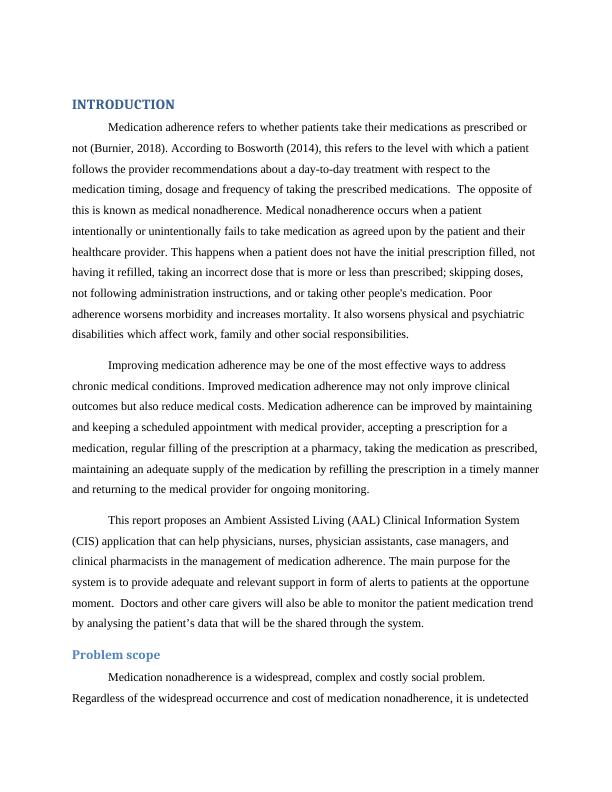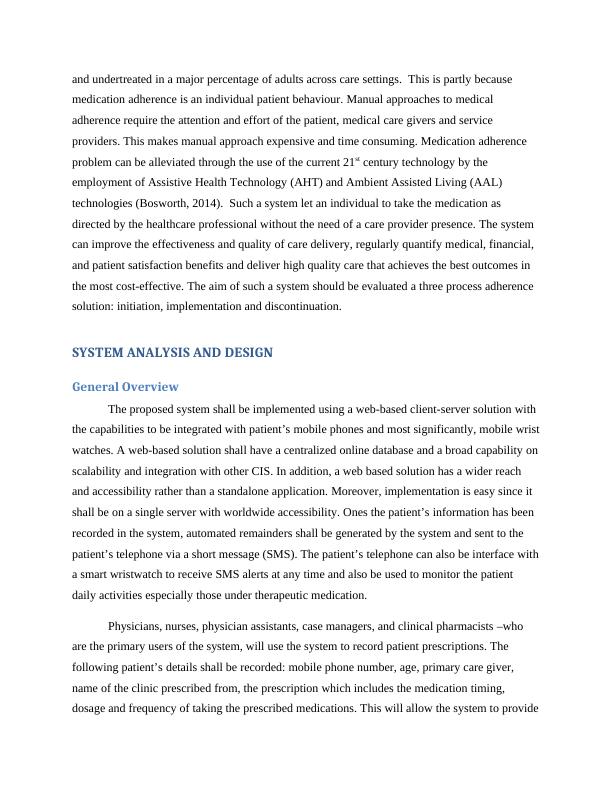Improving Medication Adherence with Ambient Assisted Living (AAL) Clinical Information System
Design a Clinical Information System (CIS) application that assists patients and/or clinicians in the management of Medication Adherence in Australia.
16 Pages2451 Words48 Views
Added on 2023-03-23
About This Document
This report discusses the importance of medication adherence and proposes an Ambient Assisted Living (AAL) Clinical Information System (CIS) application to improve medication adherence. It explores the system architecture, security elements, and user roles.
Improving Medication Adherence with Ambient Assisted Living (AAL) Clinical Information System
Design a Clinical Information System (CIS) application that assists patients and/or clinicians in the management of Medication Adherence in Australia.
Added on 2023-03-23
ShareRelated Documents
Name of University
Introduction to Health Informatics
Student Name
Course Name
Submission Date
Introduction to Health Informatics
Student Name
Course Name
Submission Date

Table of Contents
INTRODUCTION...........................................................................................................................3
Problem scope..............................................................................................................................3
SYSTEM ANALYSIS AND DESIGN...........................................................................................4
General Overview........................................................................................................................4
Assumptions/Constraints/Risks...................................................................................................5
Assumptions............................................................................................................................5
Constraints...............................................................................................................................6
Risks........................................................................................................................................6
SYSTEM ARCHITECTURE..........................................................................................................6
System architecture:.................................................................................................................7
Security Elements of the system..............................................................................................8
System users................................................................................................................................8
UML diagrams.............................................................................................................................8
i. Use case.............................................................................................................................8
ii. Class Diagram...............................................................................................................9
iii. State diagram...............................................................................................................10
IMPLEMENTATION....................................................................................................................11
REFERENCES..............................................................................................................................13
APPENDIX....................................................................................................................................14
INTRODUCTION...........................................................................................................................3
Problem scope..............................................................................................................................3
SYSTEM ANALYSIS AND DESIGN...........................................................................................4
General Overview........................................................................................................................4
Assumptions/Constraints/Risks...................................................................................................5
Assumptions............................................................................................................................5
Constraints...............................................................................................................................6
Risks........................................................................................................................................6
SYSTEM ARCHITECTURE..........................................................................................................6
System architecture:.................................................................................................................7
Security Elements of the system..............................................................................................8
System users................................................................................................................................8
UML diagrams.............................................................................................................................8
i. Use case.............................................................................................................................8
ii. Class Diagram...............................................................................................................9
iii. State diagram...............................................................................................................10
IMPLEMENTATION....................................................................................................................11
REFERENCES..............................................................................................................................13
APPENDIX....................................................................................................................................14

INTRODUCTION
Medication adherence refers to whether patients take their medications as prescribed or
not (Burnier, 2018). According to Bosworth (2014), this refers to the level with which a patient
follows the provider recommendations about a day-to-day treatment with respect to the
medication timing, dosage and frequency of taking the prescribed medications. The opposite of
this is known as medical nonadherence. Medical nonadherence occurs when a patient
intentionally or unintentionally fails to take medication as agreed upon by the patient and their
healthcare provider. This happens when a patient does not have the initial prescription filled, not
having it refilled, taking an incorrect dose that is more or less than prescribed; skipping doses,
not following administration instructions, and or taking other people's medication. Poor
adherence worsens morbidity and increases mortality. It also worsens physical and psychiatric
disabilities which affect work, family and other social responsibilities.
Improving medication adherence may be one of the most effective ways to address
chronic medical conditions. Improved medication adherence may not only improve clinical
outcomes but also reduce medical costs. Medication adherence can be improved by maintaining
and keeping a scheduled appointment with medical provider, accepting a prescription for a
medication, regular filling of the prescription at a pharmacy, taking the medication as prescribed,
maintaining an adequate supply of the medication by refilling the prescription in a timely manner
and returning to the medical provider for ongoing monitoring.
This report proposes an Ambient Assisted Living (AAL) Clinical Information System
(CIS) application that can help physicians, nurses, physician assistants, case managers, and
clinical pharmacists in the management of medication adherence. The main purpose for the
system is to provide adequate and relevant support in form of alerts to patients at the opportune
moment. Doctors and other care givers will also be able to monitor the patient medication trend
by analysing the patient’s data that will be the shared through the system.
Problem scope
Medication nonadherence is a widespread, complex and costly social problem.
Regardless of the widespread occurrence and cost of medication nonadherence, it is undetected
Medication adherence refers to whether patients take their medications as prescribed or
not (Burnier, 2018). According to Bosworth (2014), this refers to the level with which a patient
follows the provider recommendations about a day-to-day treatment with respect to the
medication timing, dosage and frequency of taking the prescribed medications. The opposite of
this is known as medical nonadherence. Medical nonadherence occurs when a patient
intentionally or unintentionally fails to take medication as agreed upon by the patient and their
healthcare provider. This happens when a patient does not have the initial prescription filled, not
having it refilled, taking an incorrect dose that is more or less than prescribed; skipping doses,
not following administration instructions, and or taking other people's medication. Poor
adherence worsens morbidity and increases mortality. It also worsens physical and psychiatric
disabilities which affect work, family and other social responsibilities.
Improving medication adherence may be one of the most effective ways to address
chronic medical conditions. Improved medication adherence may not only improve clinical
outcomes but also reduce medical costs. Medication adherence can be improved by maintaining
and keeping a scheduled appointment with medical provider, accepting a prescription for a
medication, regular filling of the prescription at a pharmacy, taking the medication as prescribed,
maintaining an adequate supply of the medication by refilling the prescription in a timely manner
and returning to the medical provider for ongoing monitoring.
This report proposes an Ambient Assisted Living (AAL) Clinical Information System
(CIS) application that can help physicians, nurses, physician assistants, case managers, and
clinical pharmacists in the management of medication adherence. The main purpose for the
system is to provide adequate and relevant support in form of alerts to patients at the opportune
moment. Doctors and other care givers will also be able to monitor the patient medication trend
by analysing the patient’s data that will be the shared through the system.
Problem scope
Medication nonadherence is a widespread, complex and costly social problem.
Regardless of the widespread occurrence and cost of medication nonadherence, it is undetected

and undertreated in a major percentage of adults across care settings. This is partly because
medication adherence is an individual patient behaviour. Manual approaches to medical
adherence require the attention and effort of the patient, medical care givers and service
providers. This makes manual approach expensive and time consuming. Medication adherence
problem can be alleviated through the use of the current 21st century technology by the
employment of Assistive Health Technology (AHT) and Ambient Assisted Living (AAL)
technologies (Bosworth, 2014). Such a system let an individual to take the medication as
directed by the healthcare professional without the need of a care provider presence. The system
can improve the effectiveness and quality of care delivery, regularly quantify medical, financial,
and patient satisfaction benefits and deliver high quality care that achieves the best outcomes in
the most cost-effective. The aim of such a system should be evaluated a three process adherence
solution: initiation, implementation and discontinuation.
SYSTEM ANALYSIS AND DESIGN
General Overview
The proposed system shall be implemented using a web-based client-server solution with
the capabilities to be integrated with patient’s mobile phones and most significantly, mobile wrist
watches. A web-based solution shall have a centralized online database and a broad capability on
scalability and integration with other CIS. In addition, a web based solution has a wider reach
and accessibility rather than a standalone application. Moreover, implementation is easy since it
shall be on a single server with worldwide accessibility. Ones the patient’s information has been
recorded in the system, automated remainders shall be generated by the system and sent to the
patient’s telephone via a short message (SMS). The patient’s telephone can also be interface with
a smart wristwatch to receive SMS alerts at any time and also be used to monitor the patient
daily activities especially those under therapeutic medication.
Physicians, nurses, physician assistants, case managers, and clinical pharmacists –who
are the primary users of the system, will use the system to record patient prescriptions. The
following patient’s details shall be recorded: mobile phone number, age, primary care giver,
name of the clinic prescribed from, the prescription which includes the medication timing,
dosage and frequency of taking the prescribed medications. This will allow the system to provide
medication adherence is an individual patient behaviour. Manual approaches to medical
adherence require the attention and effort of the patient, medical care givers and service
providers. This makes manual approach expensive and time consuming. Medication adherence
problem can be alleviated through the use of the current 21st century technology by the
employment of Assistive Health Technology (AHT) and Ambient Assisted Living (AAL)
technologies (Bosworth, 2014). Such a system let an individual to take the medication as
directed by the healthcare professional without the need of a care provider presence. The system
can improve the effectiveness and quality of care delivery, regularly quantify medical, financial,
and patient satisfaction benefits and deliver high quality care that achieves the best outcomes in
the most cost-effective. The aim of such a system should be evaluated a three process adherence
solution: initiation, implementation and discontinuation.
SYSTEM ANALYSIS AND DESIGN
General Overview
The proposed system shall be implemented using a web-based client-server solution with
the capabilities to be integrated with patient’s mobile phones and most significantly, mobile wrist
watches. A web-based solution shall have a centralized online database and a broad capability on
scalability and integration with other CIS. In addition, a web based solution has a wider reach
and accessibility rather than a standalone application. Moreover, implementation is easy since it
shall be on a single server with worldwide accessibility. Ones the patient’s information has been
recorded in the system, automated remainders shall be generated by the system and sent to the
patient’s telephone via a short message (SMS). The patient’s telephone can also be interface with
a smart wristwatch to receive SMS alerts at any time and also be used to monitor the patient
daily activities especially those under therapeutic medication.
Physicians, nurses, physician assistants, case managers, and clinical pharmacists –who
are the primary users of the system, will use the system to record patient prescriptions. The
following patient’s details shall be recorded: mobile phone number, age, primary care giver,
name of the clinic prescribed from, the prescription which includes the medication timing,
dosage and frequency of taking the prescribed medications. This will allow the system to provide

End of preview
Want to access all the pages? Upload your documents or become a member.
